At the end of this I make an admission — but why wait? I prefer Heaven Knows, Mr. Allison to the better known The African Queen, two movies from the same director (John Huston) and superficially similar. I like this movie and always have. But be warned! It’s a quiet one; it’s characterized by restraint.
When style beats the pants off of story
Among the many fascinating and, in this case, amazing things about The Maltese Falcon is that it was the first film for Sydney Greenstreet who was 62 years old at the time. Can you imagine any actor today getting a role, much less starting a career at 62?
High Sierra: When the bad guy is the good guy
I recently finished reading Stefan Kanfer’s Tough Without a Gun: The Life and Extraordinary Afterlife of Humphrey Bogart. (The title is from something Raymond Chandler said of Bogart.) So of course, I’m back to watching Bogart movies, at least for the time being.
Chinatown and the self-aware noir
It’s Day 5 of For the Love of Film (Noir) — don’t forget to or use the button on the right. And if you are interested in boatloads of great links to musings on film noir and its films, scroll down this page at Self-Styled Siren or over at Ferdy on Films. This is wonderful material! (Also see today’s Blogathon Notes.)
One of the few things I’m certain about with the movies that started this whole film noir business, movies from the forties and fifties like The Big Heat, Double Indemnity, or Gilda, is that they were not aware of themselves as being in a genre called film noir. They might have thought of themselves as B-movies, crime movies or pulp, but not film noir. Categorization like that always comes after the fact.
But once an approach or style is identified, like film noir, subsequent movies taking that approach are self-aware. They see themselves as film noir and inevitably try to replicate the approach. They may try to do much more, but they can’t be made the same way as the original film noirs were. Awareness affects what is being created.
Just as you can’t see the same movie twice (not in the same way), you can’t make the same kind of movie twice. But you can come damn close!
Chinatown (1974)
Directed by Roman Polanski
Chinatown, a wonderful movie, is an example of what a script can do for a film.
It’s like finding the right music at a party. Someone feels compelled to dance, then another and another. Soon, everyone’s up dancing. And dancing well.
In Chinatown, just about every artist is dancing their damnedest because the script has pulled them onto the floor. Director, actors, lighting people, costume designers … they’re all performing at their highest level.
It’s Robert Towne’s script that has done this.
One of Roman Polanski’s great talents is creating mood and few films do it so well and so quickly as the opening of Chinatown. I can’t think of many movies I would watch simply to see the opening credits but the look and the marvellous music of the introductory credit sequence is just so good with its period lettering and sepia tone (which carries through the movie), that you’re hooked even before the movie has presented its opening shot.
Modelling itself on the film noir style (particularly films like Howard Hawks’ movie The Big Sleep), the film’s mystery is created by presenting the story through the eyes of detective Jake Gittes, the Jack Nicholson character. We know what he knows, we’re puzzled by what he’s puzzled by, we’re misled by what misleads him. In fact, just as Bogart was in just about every scene of The Big Sleep, Nicholson is in just about every scene in Chinatown, either as a participant or as an observer.
But the film isn’t dependent on Nicholson. Faye Dunaway is perfectly cast as the enigmatic, and troubled, Evelyn Mulwray. It’s hard to imagine anyone else but Dunaway in that role. The movie is also bolstered by brilliant supporting performances, particularly John Huston as Noah Cross.
I also love the leisurely way the movie unfolds. Unlike the quick cuts and thrumming soundtrack of most current movies, Polanski takes his time. And it works so well. This may be the reason why it works. You’re seduced by the mood, and become involved with the characters, and thus the story.
Chinatown is a great, fascinating movie that illustrates the importance of beginning with a great script.
With the DVD … it’s okay. Not great, could be a lot better, but adequate. It’s largely clean and clear, but certainly not on the pristine level.
This is partly due to it being an older film (1974). For extras, there is really just one (I don’t count trailers as extras).
There is a documentary of sorts. It features interview clips with director Roman Polanski, writer Robert Towne, and producer Robert Evans.
There are some interesting comments, but there is really no depth to it … Par for the course with DVD extras.
(Note: This was written more than 10 years ago. The DVD comments refer to an early DVD release. The movie has since been released in a “special edition” which, I believe, is an improvement.)
Key Largo: truly an ensemble movie
After The Big Sleep, John Huston’s Key Largo is my favourite Bogie and Bacall movie. Another good one is To Have And Have Not and the fourth would be Dark Passage, the weakest of them all because it is so wrong-headed.
Key Largo is partly interesting because the famous Bogie-Bacall chemistry is pretty much irrelevant. It may be there, but so what? This movie is about the story, the drama and all the characters. I think we can thank John Huston for that.
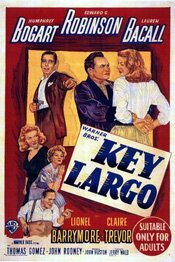 Key Largo (1948)
Key Largo (1948)
Directed by John Huston
Of the four movies Humphrey Bogart and Lauren Bacall made together, Key Largo is the last. What strikes me as interesting about it is how, despite the romance suggested between the characters, Bacall is almost a minor character in the movie. But then, in a sense, so are all the characters.
This is truly an ensemble movie, perhaps because it began as a play. You might expect it to focus on Bogart and Bacall, especially given their fame as a couple, but it doesn’t.
Director (and co-writer) John Huston is more interested in the story.
As the movie plays out, the film seems to hand the lead role off from Bogart, then to Robinson, then to Barrymore, then to Trevor, and then back to Bogart again. At the same time, Huston emphasizes place – in this case, the Florida Keys – as a major character, as he does with the hurricane.
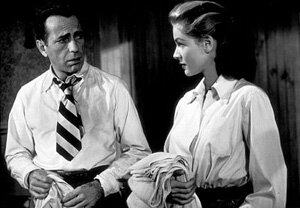 Having left the Army, ex-Major Frank McCloud goes to Key Largo to pay respects to the family of one of the soldiers under his command who was killed in action. McCloud seems a bit aimless having left the army; this obligation he feels to visit the family is about the only purpose he has at this stage in his life.
Having left the Army, ex-Major Frank McCloud goes to Key Largo to pay respects to the family of one of the soldiers under his command who was killed in action. McCloud seems a bit aimless having left the army; this obligation he feels to visit the family is about the only purpose he has at this stage in his life.
The family owns a hotel in Key Largo and when McCloud gets there both he (and we, the audience) sense something is up. Some shady characters are hanging around the hotel and they seem eager for McCloud to leave.
As the movie unfolds, it turns out they are criminals. They take over the hotel as they await other criminals to meet up with them in order to conclude a deal concerning counterfeit money. It also turns out they are led by Johnny Rocco (Edward G. Robinson) who has returned to reclaim his life and position in the criminal world, from which he has been gone for eight years (likely in prison).
Unfortunately for the gang of thugs, this is Florida and it is hurricane season and one is blowing in.
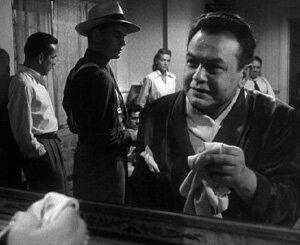 What the movie does is to bring all these characters together in one place and confine them in close quarters. You feel the walls closing in, so to speak, as the winds get stronger and shutters are closed. They are all closed in; sunlight vanishes.
What the movie does is to bring all these characters together in one place and confine them in close quarters. You feel the walls closing in, so to speak, as the winds get stronger and shutters are closed. They are all closed in; sunlight vanishes.
The movie’s true is star is arguably Edward G. Robinson. He’s mean and menacing and dominates everything around him. Once he appears in the movie (which is not immediate), he seldom leaves the frame.
There is a curious contrast between Robinson’s Johnny Rocco and the other characters. In many ways, they are all frozen in the moment, unsure what to do (except Rocco). Because of the death of Bacall’s husband, who is also Barrymore’s son, those two are stuck. McCloud, discharged from the Army, is unsure what to do with his life. They would all like to go forward; they’re just not sure how.
But Johnny Rocco has no interest in going forward. He wants to go back. He wants to reclaim and relive his former glory. He lives in, and dreams of, the past. Claire Trevor’s character, Gaye Dawn, is also stuck in the past because she is still connected with Rocco and she is an alcoholic. The relationship is abusive but she is dependent on Rocco, or so she feels. She is stuck and, because of her association with Rocco, it is the past she is stuck in.
Just as they are all confined within the hotel, so they are confined within this moment of uncertainty about their lives. They aren’t living in the present; they are confined within it.
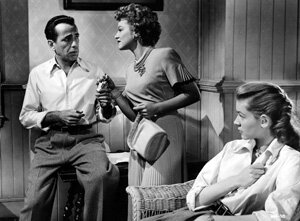 Tension builds in the movie partly because of the storm, partly because Johnny Rocco gets increasingly anxious about completing his deal, but also because of the forward and backward pull between the characters: Johnny’s will to go back to the past; McCloud and the others’ desire to break free and go forward into the future.
Tension builds in the movie partly because of the storm, partly because Johnny Rocco gets increasingly anxious about completing his deal, but also because of the forward and backward pull between the characters: Johnny’s will to go back to the past; McCloud and the others’ desire to break free and go forward into the future.
Dramatic and suspenseful, Key Largo is a tremendous example not just of good filmmaking but of good drama, period. It’s a good story well told. I loved it.
On Amazon:
- Key Largo (DVD) — Amazon.com (U.S.)
- Key Largo (DVD) — Amazon.ca (Canada)
20 Movies: Chinatown (1974)
The problem with listing these 20 movies is that I’m building a list of movies I want to see again. But I guess that’s not such a bad thing.
With Chinatown, we get an enthralling mystery and one of the best examples of what a strong script will do for a movie.
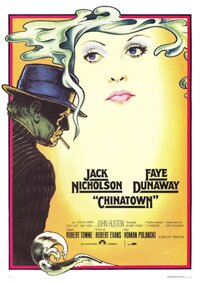 Chinatown (1974)
Chinatown (1974)
directed by Roman Polanski
Chinatown, a wonderful movie, is an example of what a script can do for a film.
It’s like finding the right music at a party. Someone feels compelled to dance, then another and another.
Soon, everyone’s up dancing. And dancing well.
In Chinatown, just about every artist is dancing their damnedest because the script has pulled them onto the floor. Director, actors, lighting people, costume designers … they’re all performing at their highest level.
It’s Robert Towne’s script that has done this.
One of Roman Polanski’s great talents is creating mood and few films do it so well and so quickly as the opening of Chinatown. I can’t think of many movies I would watch simply to see the opening credits but the look and the marvellous music of the introductory credit sequence is just so good with its period lettering and sepia tone (which carries through the movie), that you’re hooked even before the movie has presented its opening shot.
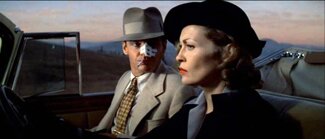 Modelling itself on the film noir style (particularly films like Howard Hawks’ movie The Big Sleep), the film’s mystery is created by presenting the story through the eyes of detective Jake Gittes, the Jack Nicholson character. We know what he knows, we’re puzzled by what he’s puzzled by, we’re misled by what misleads him. In fact, just as Bogart was in just about every scene of The Big Sleep, Nicholson is in just about every scene in Chinatown, either as a participant or as an observer.
Modelling itself on the film noir style (particularly films like Howard Hawks’ movie The Big Sleep), the film’s mystery is created by presenting the story through the eyes of detective Jake Gittes, the Jack Nicholson character. We know what he knows, we’re puzzled by what he’s puzzled by, we’re misled by what misleads him. In fact, just as Bogart was in just about every scene of The Big Sleep, Nicholson is in just about every scene in Chinatown, either as a participant or as an observer.
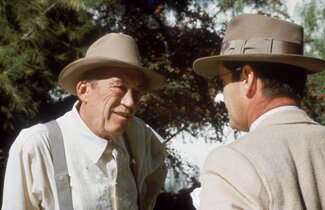 But the film isn’t dependent on Nicholson. Faye Dunaway is perfectly cast as the enigmatic, and troubled, Evelyn Mulwray. It’s hard to imagine anyone else but Dunaway in that role. The movie is also bolstered by brilliant supporting performances, particularly John Huston as Noah Cross.
But the film isn’t dependent on Nicholson. Faye Dunaway is perfectly cast as the enigmatic, and troubled, Evelyn Mulwray. It’s hard to imagine anyone else but Dunaway in that role. The movie is also bolstered by brilliant supporting performances, particularly John Huston as Noah Cross.
I also love the leisurely way the movie unfolds. Unlike the quick cuts and thrumming soundtrack of most current movies, Polanski takes his time. And it works so well. This may be the reason why it works. You’re seduced by the mood, and become involved with the characters, and thus the story.
Chinatown is a great, fascinating movie that illustrates the importance of beginning with a great script.
See: 20 Movies – The List
Chinatown (the trailer)
Finally, The African Queen
I saw on the TCM home page something that caught my eye: (1951) being released on March 23, 2010 in a “Commemorative Box Set.” I care less about the box set business than I do about this note (found in the information on Amazon): “Fully Restored using state-of-the-art restoration process.”
I have been waiting forever to get a decent copy of this movie on DVD. You would think this would have been one of the movies that had been released as a DVD long ago — and released several times over. But that has not been the case. I believe rights problems may have made a mess of things (if I recall correctly). Maybe it was public domain? I no longer remember.
The point, however, is that it is finally coming, if a little pricey because it’s a box set. On the other hand, I find what is included intriguing. Amazon lists the special features as:
– Fully Restored using state-of-the-art restoration process
– Includes all-new hour long “making of” feature with never-before-seen images and commentary
– Collectible packaging highlighting Humphrey Bogart and Katharine Hepburn
– Second disc with the original Lux radio broadcast of The African Queen starring Humphrey Bogart and Greer Garson (Audio CD)
– Reproduction of Katharine Hepburn’s out-of-print published memoir: The Making of The African Queen or How I Went to Africa with Bogart, Bacall and Huston and Almost Lost My Mind
– Collectible Senitype®: a four film frame card illustrating the Technicolor® process
– 8 images inspired by original theatrical lobby cards
The release date is March 23. And apparently there will be a Blu-Ray version too. I am waiting.


